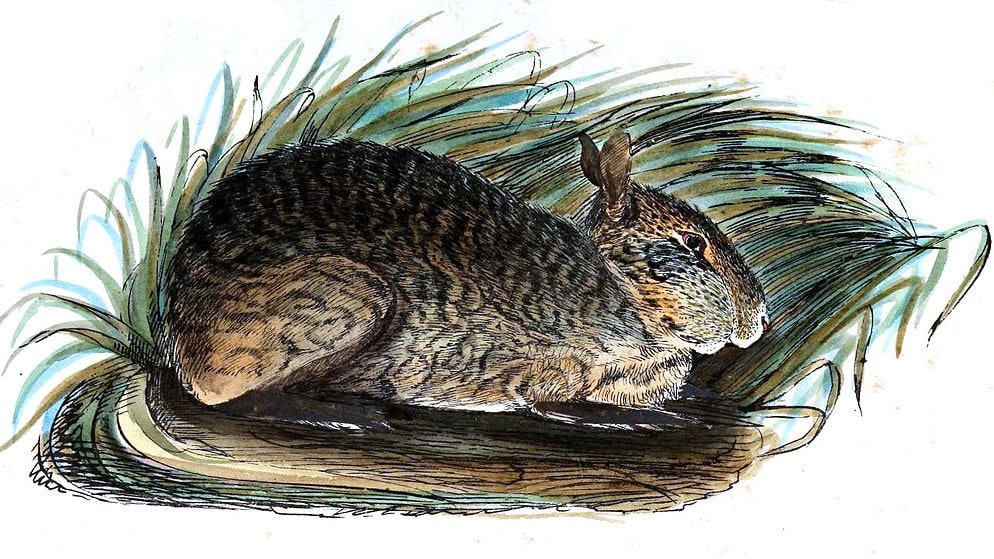 Listen to this article
•
15:34 min
Listen to this article
•
15:34 min
Sighting a hispid hare is not easy in the southern foothills of the Himalayas in Nepal, India, and Bhutan. But if you do spot it, the hare, Caprolagus hispidus is easily recognisable by its coarse, dark-brown fur on the dorsal side, featuring a mix of black and brown hair, and a ventral coat that is brown on the chest and whitish on the abdomen. Commonly referred to as the ‘bristly rabbit’, this shy and elusive species is considered to be one of the world’s rarest mammals within a monotypic genus (a genus that contains only a single species). Despite being classified as Endangered by the IUCN Red List and holding Schedule I status under the Indian Wildlife (Protection) Act, 1972, there remains a significant knowledge gap regarding its distribution.
To bridge this gap, a new study has now used the species distribution model approach to predict the future of the hispid hare under various scenarios of climate change, loss of its grassland habitat, and urbanisation. “We found was that if current climate change trends continue, the hispid hare will likely be confined to small, isolated patches of habitat, facing a high risk of extinction,” says Shantanu Kundu, who is an assistant professor at Pukyong National University in the Republic of Korea and one of the authors of the study. To counter this, the study recommends suitable protected areas for conservation under both current and future climatic conditions.
Will the hispid hare beat the odds?
Historically, the hispid hare inhabited the southern foothills of the Himalayas in Uttar Pradesh, across Nepal, and extending into West Bengal and Assam, with its southern range reaching Dhaka in Bangladesh. Currently, however, its distribution is restricted to isolated tropical grasslands in Nepal, Bhutan and India, within an elevation range of 100-250 metres.

Cover Photo: An illustration of a hispid hare. Illustration: J. Hendrie, text: Edward Blyth, Public domain, via Wikimedia Commons
For this study, the geographical range encompassed both the historical range and the current range as assessed by the IUCN Red List specialist group. Data was also gathered from secondary sources, including the Geospatial Conservation Assessment Tool (GeoCat), which synchronises with GBIF and iNaturalist, along with peer-reviewed scientific literature.
A total of 102 identified locations of the hispid hare were used in the study. Various factors affecting habitat suitability, including climatic, habitat, anthropogenic, and topographic variables, were considered for the development of the species distribution model.
The study revealed that out of the total geographical extent of 1,88,316 square kilometres studied, only 11,374 square kilometres (6.03%) provide suitable habitat for the hispid hare. The extent of habitat significantly declined across its range (more than 60% of the habitat experienced decline) under certain climate change scenarios. Under the severe emissions scenarios particularly, there is a risk of drastic habitat loss and fragmentation.
The researchers also found that the protected area of Shuklaphanta National Park in Nepal was the most suitable habitat for the hispid hare, while Dibru-Saikhowa National Park in Assam was identified as the most suitable habitat in India. Additionally, Corbett National Park and Sonanadi Wildlife Sanctuary in Uttarakhand demonstrated as effective habitats for the species. “These findings highlight the need for proactive conservation strategies to mitigate climate change impacts, including potential species translocation to areas with future habitat suitability,” says Imon Abedin, from the Indian Statistical Institute in Kolkata and Aaranyak and one of the study’s co-authors.
Incidentally, the study’s findings are contrary to previous studies which suggested that Shuklaphanta National Park in Nepal was less suited for the hare. “Corbett National Park and Sonanadi Wildlife Sanctuary in Uttarakhand too showed high mean habitat suitability, despite no reported sightings of the species. These findings suggest that the hispid hare may be present but overlooked in these areas, indicating a need for further research and potential conservation efforts in these regions,” says Tanoy Mukherjee from the Indian Statistical Institute in Kolkata and another researcher who co-authored the study.

An overlooked but crucial inhabitant of grasslands
The hispid hare plays a crucial role in maintaining ecological balance within grassland ecosystems. However, it is often overlooked in conservation efforts due to its lack of charismatic appeal and elusive, nocturnal nature. Consequently, conservation resources are typically directed toward larger, more prominent species perceived to have higher ecological or economic value.
Today, the primary threats to the hispid hare include habitat loss and fragmentation due to natural succession, overgrazing by cattle, unregulated thatch collection, and the conversion of grasslands to agricultural lands. It has confined the species to isolated patches of grassland within national parks, and its population continues to rapidly decline due to anthropogenic pressures and grassland fires across its range. Particularly, seasonal burning practices to stop succession, which overlap with the breeding season of the hispid hare could have a potentially negative impact on the species’ survival.
Climate change further exacerbates these issues. Shifts in temperature and precipitation patterns directly influence vegetation cover and the availability of suitable food resources for the hispid hare.
Work in progress
To counter the decline of the hispid hare and its habitat, the study recommends prioritising efforts to restore degraded habitats within the hare’s range, while enhancing protection in identified suitable habitats and climate refugia (areas that remain more or less the same despite changes in the surrounding landscape). It also emphasises conducting detailed ecological studies to better understand the hare’s needs and threats, and promoting coordinated conservation action between Nepal, India, and Bhutan.
“Controlled burns should be implemented with proper ecological management in protected areas and surrounding grasslands. Translocation opportunities and captive breeding programs should be explored to prevent eradication. Additionally, managing overgrazing within protected areas and adjacent lands is crucial,” says Kundu.
Only by addressing the challenges posed by climate change and habitat loss, and fostering international cooperation can the future of this endangered species be safeguarded.
This story was first published on Mongabay India
Photo sources: illustration, Shuklaphanta National Park





